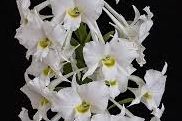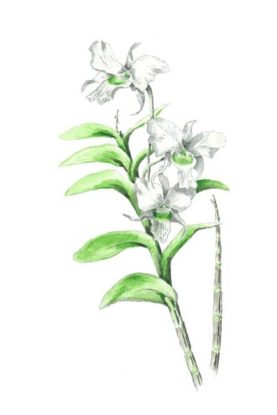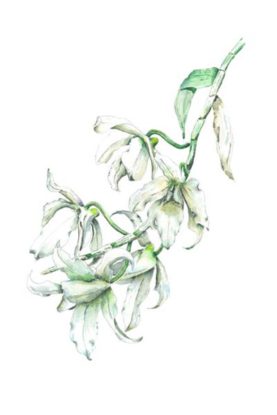
An exciting orchid conservation project, and a glimpse into history
People often ask me why I am so excited about orchid conservation, and why I put so much effort into it. The answer is pretty simple. I have done a fair amount of reading about explorers and botanists who discovered various species of orchids in the 1800’s, and I imagine what the world was like then. So many huge areas of wilderness, so many animals never before seen, so many plant species never catalogued.
These stories always stoke my excitement about conservation. The thought that there may still be areas resembling the world as explored 100 years ago is a great motivator for me in my conservation efforts. Whenever new species are discovered, I always get deep satisfaction out of knowing that I am playing a part in preserving their habitat.
An orchid so beautiful, I had to paint it twice. And I’m not done yet.
One of my favorite dendrobium species is the Dendrobium dearei. I have a cultivar that recently finished blooming in my greenhouse, and it looks like it is surviving another brutal Dallas summer. This plant is one I bought to replace the original cultivar which I painted in 2005.
 The one from 2005 did not survive, unfortunately. It may have succumbed to the heat of a prior summer, or possibly to “the curse of the paintbrush”. All too many of my painting are of plants that are mere memories in my collection. I’m beginning to believe that the curse is for real. Just kidding, of course.
The one from 2005 did not survive, unfortunately. It may have succumbed to the heat of a prior summer, or possibly to “the curse of the paintbrush”. All too many of my painting are of plants that are mere memories in my collection. I’m beginning to believe that the curse is for real. Just kidding, of course.
This species Dendrobium dearei was discovered in the Philippines in 1882 by Colonel Deare. Very little is known about this gentleman, other than the fact that in addition to his botanical forays to the Philippines, he also explored Borneo.
At the same time, he founded and maintained a well-known exotic garden near England in the 1880’s. We do know the Dendrobium dearei is documented from an area north of Mindanao and east of Leyte, that includes Dinagat Island and Surigao. That is the extent of what we know about the Colonel’s explorations in the Philippines.
My 5-year work assignment in the Philippines introduced me to orchids
During my own five years working in the Philippines, I was situated in the northern mountainous region of the Philippines, representative of the well-defined wet and dry season.
 The Dendrobium anosmum, another favorite of mine from Luzon, requires the dry period in the winter to produce its prolific floral canes. This well-defined wet/dry climate type is found on the western side of the Philippines, all the way down to the Zamboanga and Palawan regions, the southernmost phase of my travels during my stay in the Philippines.
The Dendrobium anosmum, another favorite of mine from Luzon, requires the dry period in the winter to produce its prolific floral canes. This well-defined wet/dry climate type is found on the western side of the Philippines, all the way down to the Zamboanga and Palawan regions, the southernmost phase of my travels during my stay in the Philippines.
I never visited Dinaget Island and the Surigao region further east, where there is no pronounced maximum rain period and no dry period. This region represents a “Philippines” I never experienced — a totally different world from the area I was familiar with. But this is the climate where the Dendrobium dearei is found, and it explains why it blooms so beautifully in the spring, after having received fairly regular “greenhouse rainfall” during the winter.
Because I have such a fondness for the Philippine species of orchids, they often end up as subjects for my paintings. You can view a slideshow of my Philippine orchid paintings here.
Phlippine Orchids are rapidly losing their habitat
The loss of habitat in the Philippines is a source of great sadness for me. Books written during the 1950’s talk of a world that had all but disappeared by the time I arrived in the area in 1980. At that point little effort was being made to preserve what was left.
 You can imagine the surprise and delight when I learned that our perennially supported friend in conservation, The Rainforest Trust, has just established a 16,000 acre project to protect the habitat of Dinaget Island in the Philippines.
You can imagine the surprise and delight when I learned that our perennially supported friend in conservation, The Rainforest Trust, has just established a 16,000 acre project to protect the habitat of Dinaget Island in the Philippines.
I’m proud of the fact that GNTOS (Greater North Texas Orchid Society), of which I am a member supporting the Rainforest Trust’s project in the island of Palawan. This new project on Dinaget Island is perhaps even more significant. There exists a valuable opportunity here for all of us to take an active support in conservation.
To best highlight this magnificent biodiversity of this region, here is how the Rainforest Trust’s website introduces it:
Composed of a sprawling network of more than 7,000 islands, the Philippines contain lowland tropical rainforest, wetlands, mangroves and thousands of miles of coastline. The astounding variety of habitats makes the country a thriving hotspot for biodiversity with the highest rate of new animal species being discovered, as 15 new mammal species were discovered just in the last 10 years.
Despite the nation’s incredible biodiversity value, many of its natural resources remain unprotected. Smaller islands within the Philippines are rich in rare and endemic species, like Dinagat Island off the north coast of Mindanao, and they are particularly at risk. Recognized as a Key Biodiversity and Important Bird Area with several rare and endemic species, Dinagat Island remains without any formal government-sanctioned protected areas. The island provides a haven to the Critically Endangered Dinagat Bushy-tailed Cloud Rat, the shrew-like Dinagat Gymnure and an endemic form of the Philippine Tarsier.
To save the island’s unique and endangered wildlife, Rainforest Trust is working with local partner Green Mindanao to create four new protected areas that will secure much-needed forest and coastal habitat. Given the global downturn in commodities, the locally progressive government is poised to seize this opportunity to work together with local mining companies for the mutual benefit of both conservation and sustainable development on Dinagat Island.
 A donation of $8.59 will protect one acre of this valuable habitat. At the time of this writing, a matching grant is in effect, so your donation of $8.59 actually protects two acres. It takes just a few moments to make a donation. Simply visit the Rainforest Trust’s website and click on “Donate”.
A donation of $8.59 will protect one acre of this valuable habitat. At the time of this writing, a matching grant is in effect, so your donation of $8.59 actually protects two acres. It takes just a few moments to make a donation. Simply visit the Rainforest Trust’s website and click on “Donate”.
Organizations like the Rainforest Trust make it so simple for all of us to be involved in preserving these fragile ecosystems. Most of us can afford at least an acre. Please join me.![]()